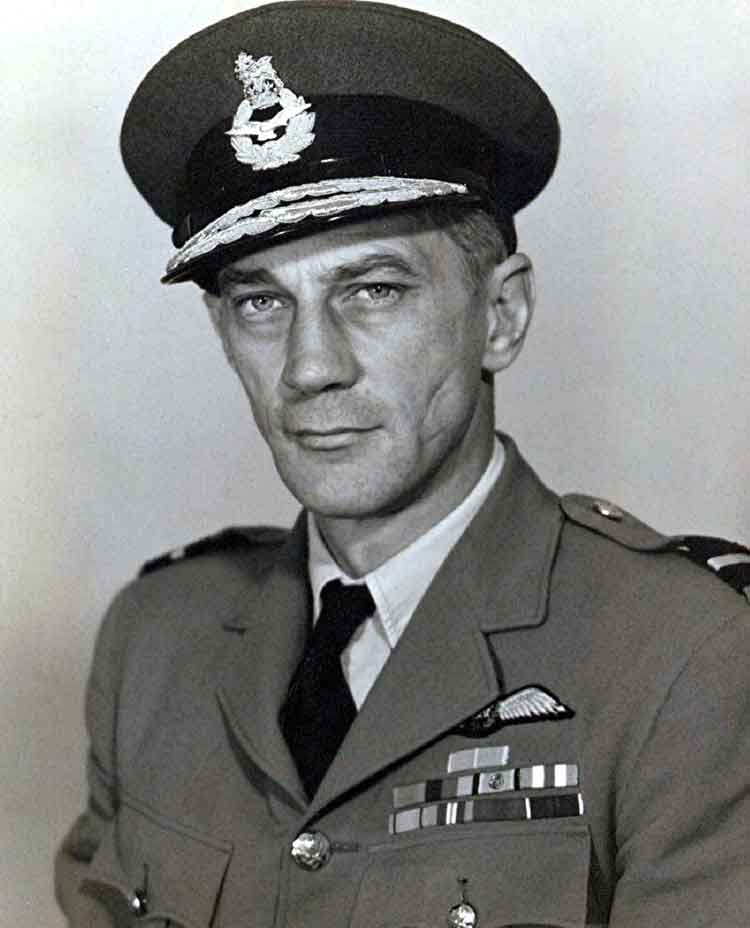
 Born: 19 Jun 1913 Invercargill, New Zealand Retired: 20 Aug 1962 Died: 12 Jul 2000 Orange, NSW, Australia
Born: 19 Jun 1913 Invercargill, New Zealand Retired: 20 Aug 1962 Died: 12 Jul 2000 Orange, NSW, Australia
 Decorations:
Decorations:

CBE 29 Jun 1948, DSO 22 Feb 1944.
 Promotions:
Promotions:

Pilot Officer: 15 Jul 1933

Flying Officer: 15 Jan 1935

Flight Lieutenant: 15 Jan 1937

Squadron Leader: 1 Apr 1939

Acting Wing Commander: 15 Sep 1940

Temporary Wing Commander: 1 Jun 1941

Acting Group Captain: 12 Oct 1942

Wing Commander (WS): 12 Apr 1943

Wing Commander:1 Oct 1946

Group Captain: 1 Jan 1951

Acting Air Commodore: 25 Jan 1954

Air Commodore: 1 Jan 1957.
 Postings:
Postings:

03 Sep 1931: Flight Cadet, 'C' Sqn, RAF College.

15 Jul 1933: Pilot, No 16 Sqn.

15 Jan 1937: Flight Commander, No 16 Sqn.

01 Sep 1939: Member, British Military Mission to Poland.

11 Oct 1939: Officer Commanding, No 225 Sqn.

05 Sep 1940: Officer Commanding, No 4 Sqn.

18 Sep 1940: Officer Commanding, No 239 Sqn.

08 Sep 1942: Air Staff, HQ Army Co-operation Command.

12 Oct 1942: Officer Commanding, No 33 Wing

01 Apr 1943: Officer Commanding No 35 Wing

30 Aug 1944: Staff, School of Land/Air Warfare.

03 Apr 1946: Air Staff, HQ RAF Levant

25 Aug 1948: Attended RCAF Staff College.

11 Sep 1949: Exchange posting, USAF.

01 Jan 1951: Officer Commanding, RAF Chivenor.

25 Jan 1954: Air Attaché, Moscow.

28 May 1956: Assistant Chief of Staff (Intelligence), HQ Allied Air Forces Central Europe.

06 Jan 1959: Attended Imperial Defence College.

13 Feb 1960: AOC, RAF Hong Kong.
Life Story:

He represented the RAF College at Rugby and Boxing and attained the rank of Flight Cadet Corporal.

On graduating from Cranwell, he joined No 16 (Army Co-operation), then flying the Armstrong Whitworth Atlas but by the time he left the squadron as a flight commander in 1938, it had re-equipped twice, first with the Hawker Audax and then the Westland Lysander.
King Carol with the RAF
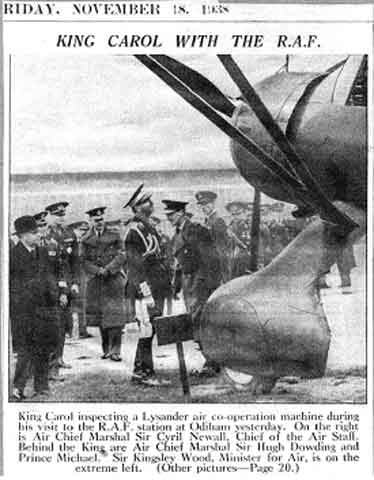

King Carol inspecting a Lysander air co-operation machine during his visit to the RAF Station at Odiham yesterday.

On the right is Air Chief Marshal Sir Cyril Newall, Chief of the Air Staff (later Marshal of the RAF The Lord Newall of

Clifton upon Dunsmoor). Behind the King are Air Chief Marshal Sir Hugh Dowding, Air Officer Commanding-in-Chief,

Fighter Command (later Air Chief Marshal Lord Dowding of Bentley Priory - famous for the Battle of Britain) and

Prince Michael of Romania. Sir Kingsley Wood, Minister for Air, is on the extreme left.
Peter Donkin is standing in front

of the Lysander. 17th November 1938.
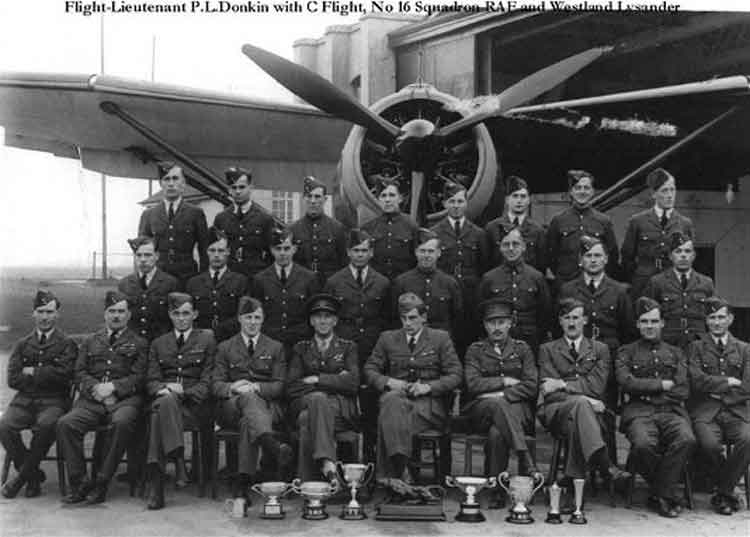

A brief break followed towards the end of August, 1939. when he was sent, from learning Russian with a family on the Baltic, to Poland to join the British Military Mission in Warsaw, led at the time by the gallant, colourful and eccentric Major-General Adrian Carton de Wiart
VC, who had lost both a hand and an eye in World War I (later Lieutenant-General Sir Adrian Carton deWiart
VC KBE CB CMG DSO). Their Air Attaché was on leave in England.

The mission was there to give assistance to the Poles and, although military equipment had been sent by train to Poland from England, the equipment was never unloaded. He liaised with the Polish General Staff who would keep insisting that England, on a visit by senior officers earlier in the year, had offered to send squadrons to Poland to assist the Poles. That was obviously thoroughly impractical and there was little he could do to answer their constant demands for reinforcements.

As he had come straight from Estonia, he had no uniform with him so, to give himself more credence with the Polish General Staff, he ordered a uniform from a tailor in a village near the British Mission. The following day he went to pick up this uniform and, as he was walking across a field to the village where the tailor lived, with an interpreter attached to the British Mission, he looked into the sky and saw several black specks approaching.

These turned out to be about eight German bombers, which proceeded to empty their bombs in and around the field where his companion and he were lying. The bombs came rather close but were fortunately not very big ones and no damage was done to them. However, when they had passed, they continued to the tailor's house, which was unfortunately no longer there - nor was the tailor.
 Squadron Leader Donkin
Squadron Leader Donkin is consequently believed to be the first allied serviceman to be attacked by the Germans in World War II.

On his return to Britain he was soon back into operational flying as
CO of No 225 Squadron flying Lysanders. He remained in active flying posts until nearly the end of WW2. Taking temporary command of
No 4 Squadron in September 1940 he was soon tasked with the formation of a new unit, No 239 Squadron. Initially formed from flights of
No's 4 and 225 Squadrons, it was equipped with Lysanders for support of IV Corps. He commanded 239 for two years, which was a long time in war time and, as when he was with No 16, the squadron's equipment was gradually upgraded through Tomahawks, Hurricanes until Mustangs arrived in May 1942.

In October 1942 he was promoted and given command of No 35 (Reconnaissance) Wing as part of the 2nd Tactical Air Force. This unit consisted of
No's 2,
4 and 268 Squadrons with 26 and 63 Squadrons being attached. Taking part in a recce operation on 13 Apr 1944, his aircraft was hit and he was forced to ditch. He was eventually found in his dinghy after six days and five nights afloat.
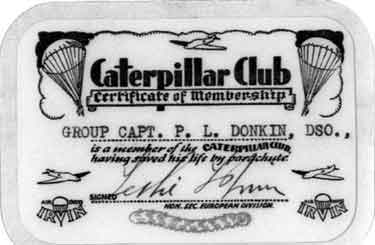
Peter's Caterpillar Club Card having saved his life by using his parachute.
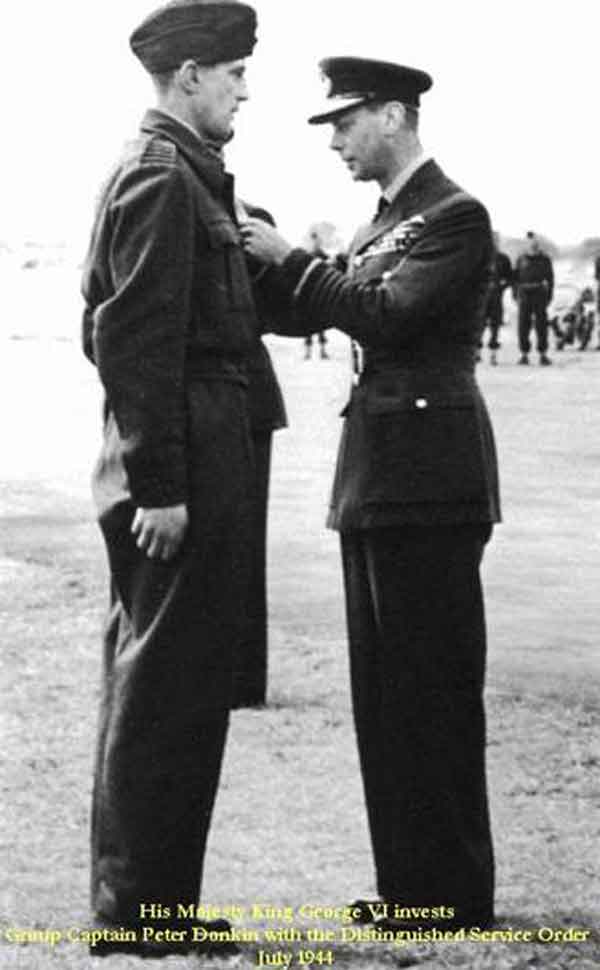
His Majesty King George VI invests Group Captain Peter Donkin with the Distinguished Service Order July 1944.




